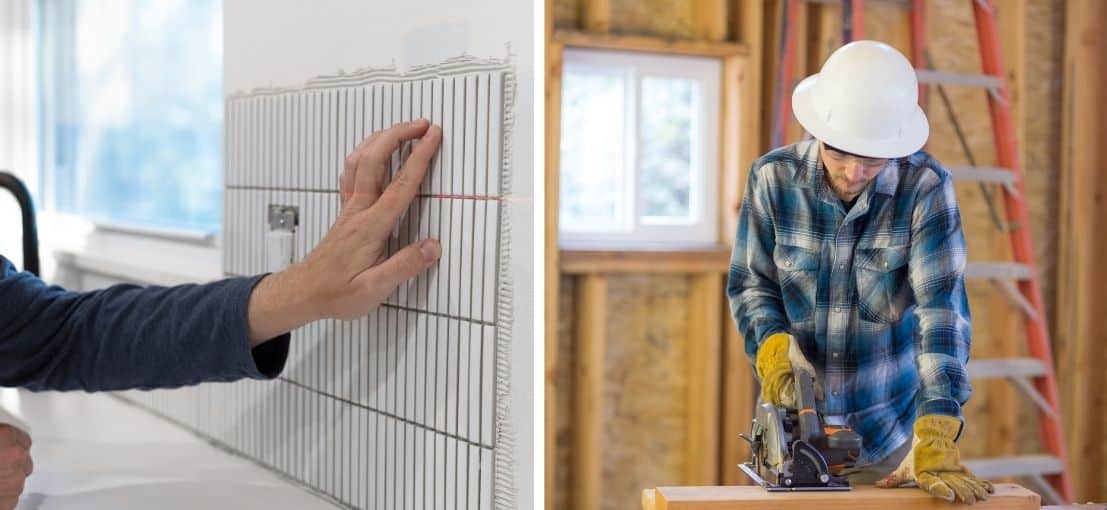
Home Fixes
|Interiors
DIY vs. Professional Remodeling: A Practical Guide to Tackling Home Remodels
If you’re a homeowner debating choosing to do a home remodeling project yourself versus hiring a contractor, you’re in the right place. We’re going over a few things homeowners should consider before DIY home remodeling, as well as some insights from the Neil Kelly team.
Things Homeowners Should Consider Before DIY Remodeling
- Do you have the time to dedicate to DIY projects? Hiring a contractor will always add to the overall cost of a project, so for smaller jobs, you might be able to save by doing the work yourself. However, if you need to take time off work or the project would take you months to finish, you may not actually be saving money or time.

- Do you have experience with DIY projects? Simple projects like painting and replacing fixtures are easy to learn as you go, but other projects like cabinet painting and installation, or installing new drywall, can be difficult and need a professional’s touch to look their best.
- How dangerous is the project? A professional should handle large-scale demolition projects, major electrical work, or anything involving heights. If you’re not already comfortable using power tools and saws, a DIY project could be a relatively dangerous endeavor for you.
Pros and Cons of DIY Remodeling: From the Neil Kelly Team
We asked Neil Kelly team members, Selah Ewert, General Manager, Bend; Amanda Armstrong Sava, General Manager, Seattle; and Barbara Miller, VP of Design Sales, to share their thoughts on DIY vs. professional design/build remodeling services.
Which Home Remodel Projects Are Okay to DIY?
According to Ewert, projects like tiling a kitchen backsplash (not tile mosaic or a shower unless you have contract experience) and landscaping are achievable projects for most homeowners. Additionally, installing hardware, painting, and small-scale demolition are good ways to cut costs by doing them yourself.
Ewert cautions DIYers to understand the complexity of their project and research materials before starting to make sure they are a good fit for the space.
What Should DIYers Consider Before They’re in Too Deep?
It’s common for DIYers to jump into a new project without first considering the scope of the project and how long each element will take. Ewert points out that DIYers may not consider which materials they’ll be ordering and installing and how long they’ll take to arrive, extending the project completion time.
Another major consideration that gets overlooked is any code involvement, approvals, and how those timelines can affect the project. Sava agrees, stating that codes are there for a reason—the safety of the home and the safety of the people living there.
What are Some Common Design Challenges in Home Improvement Projects?
Some design elements are inherently tricky, even for designers with years of experience under their belt.
The way that lighting impacts the overall outcome, as well as the flow of a space and the best ways to maximize a space, can be challenging to master, Ewert points out. And even someone with design experience can face project management challenges. 
Regarding the functionality of the home, Sava flags that DIYers might not consider things like where the dishes are going, where the storage is, or if they have dogs, where the dog food is being stored. There’s an art to learning how to talk to a contractor to make sure all of the boxes are ticked and get the very best end result. When designing a functional workspace like a kitchen or bath, you could think ‘I know exactly what I want,’ but it’s not just about what it looks like. It’s the way it all works together for your specific needs.
Miller adds that if you’re changing something fundamental to your home, like an addition, bathroom, or kitchen, consult someone who can give you an overview of what’s going to be involved so you’re not living in a construction zone and having to extend living in discomfort.
Get to Know Seattle GM Amanda Armstrong Sava
Combining DIY With Professional Remodeling
It doesn’t have to be as black and white as DIY vs. contractor. Homeowners also have the option to contribute their own sweat equity to their Neil Kelly project in order to save money.
Ewert states, “We always want to partner with our clients and make their project the most affordable. They can do their own demolition or own painting. These are gives that don’t impact the project in a huge way.” 
Sava agrees that the two main areas where clients often contribute are painting and demolition. She notes that Neil Kelly has also worked with clients who have taken on tasks like plumbing and flooring. Each designer is open to exploring the possibilities of every project to understand the client’s skills and interests, while ensuring that any work covered under Neil Kelly’s warranty is handled by the company.
As Miller says, “We can help people strategize what their strengths are, where they can put that sweat equity, and what makes sense for Neil Kelly to do.”
Learn More About VP of Design Sales Barbara Miller
Choose Neil Kelly For Design/Build Remodeling Services
If you’re ready to start your home project with design/build remodeling experts, Neil Kelly is your trusted partner in the Pacific Northwest. Whether you’re looking to completely gut and remodel your kitchen or need handyman services, you can trust Neil Kelly to bring our years of expertise to your project.